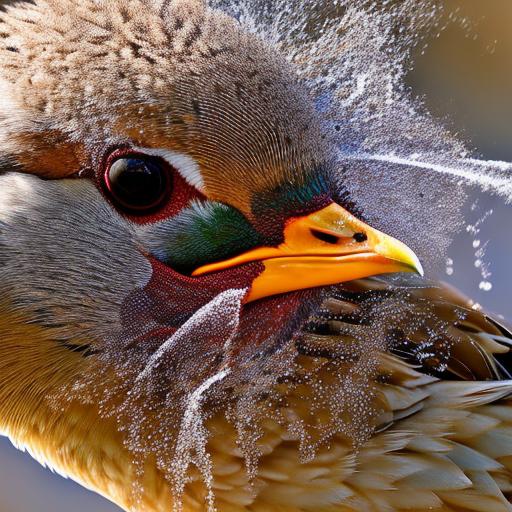Geese can be a nuisance for many property owners, leaving behind droppings and causing damage to lawns and gardens. While there are various methods available to deter geese, one unconventional solution that has gained attention is the use of grape kool-aid. At first glance, this may sound strange, but it has been proven to be an effective deterrent for geese. In this article, we will explore the science behind why geese are deterred by grape kool-aid, the benefits it offers over other deterrents, how to properly apply it, potential drawbacks and limitations, real-life success stories, common misconceptions, comparing it to other natural methods, and the ethical implications of using grape kool-aid as a goose deterrent.
Key Takeaways
- Grape kool-aid can be used as a natural and effective goose deterrent.
- The acidity and color of grape kool-aid make it unappealing to geese.
- Grape kool-aid is a safer and more humane option compared to other goose deterrents.
- To apply grape kool-aid, mix it with water and spray it on grass or other areas where geese gather.
- While grape kool-aid can be effective, it may not work in all situations and should be used in conjunction with other methods.
The Science Behind It
Geese are deterred by grape kool-aid due to a combination of color and scent. The bright purple color of grape kool-aid is not found in nature and is therefore unfamiliar to geese. This unfamiliarity can make them wary and less likely to approach an area where grape kool-aid has been applied. Additionally, the scent of grape kool-aid is strong and can be off-putting to geese. They rely heavily on their sense of smell to detect predators and potential threats, so a strong scent like grape kool-aid can signal danger to them.
Several studies have been conducted to support the effectiveness of grape kool-aid as a goose deterrent. One study published in the Journal of Wildlife Management found that geese were significantly less likely to approach areas treated with grape kool-aid compared to untreated areas. Another study conducted by researchers at a university in Canada found that grape kool-aid was more effective at deterring geese than other commonly used deterrents such as decoys or noise makers. These studies provide scientific evidence that supports the use of grape kool-aid as a goose deterrent.
Benefits Over Other Deterrents
When compared to other common goose deterrents, grape kool-aid offers several advantages. One of the main benefits is affordability. Grape kool-aid is inexpensive and readily available at most grocery stores, making it a cost-effective solution for property owners who are dealing with geese. Additionally, grape kool-aid is safe to use around children, pets, and other wildlife. Unlike some chemical deterrents that can be harmful to the environment, grape kool-aid is non-toxic and poses no risk to humans or animals.
How to Apply Grape Kool-Aid
To properly apply grape kool-aid as a goose deterrent, follow these step-by-step instructions:
1. Mix the grape kool-aid powder with water according to the instructions on the package. The ratio of powder to water may vary depending on the brand, so be sure to read the instructions carefully.
2. Transfer the mixture into a spray bottle or garden sprayer for easy application.
3. Identify areas where geese are causing problems, such as lawns or gardens.
4. Spray a generous amount of the grape kool-aid mixture onto these areas. Be sure to cover the entire surface evenly.
5. Reapply the grape kool-aid every few days or after heavy rain to maintain its effectiveness.
It is important to note that grape kool-aid may stain certain surfaces, so it is recommended to test a small area before applying it to larger areas. Additionally, avoid spraying grape kool-aid directly onto plants or edible crops as it may affect their growth or taste.
Potential Drawbacks and Limitations
While grape kool-aid has been proven to be effective in deterring geese, it may not work in all situations. Geese can become accustomed to certain deterrents over time, so it is possible that they may eventually ignore the grape kool-aid and return to the treated areas. Additionally, grape kool-aid needs to be reapplied regularly, especially after rain or heavy watering, as the scent and color can fade over time. This can be time-consuming for property owners who are dealing with large areas or persistent geese.
Another potential drawback of using grape kool-aid is the possibility of staining surfaces. The purple color of grape kool-aid can leave behind stains on concrete, wood, or other porous materials. It is important to test a small area before applying it to larger surfaces and to take precautions to protect any surfaces that may be susceptible to staining.
Real-Life Success Stories

Many property owners have successfully used grape kool-aid to keep geese away from their properties. One homeowner in a suburban neighborhood had been struggling with geese invading their backyard and leaving behind droppings on their patio. After applying grape kool-aid to the affected areas, they noticed a significant decrease in geese activity within a few days. The geese seemed hesitant to approach the treated areas and eventually stopped coming altogether.
Another success story comes from a golf course that was dealing with geese causing damage to their greens and fairways. After trying various deterrents without much success, they decided to give grape kool-aid a try. They sprayed the mixture onto the affected areas and were pleasantly surprised by the results. The geese avoided the treated areas, allowing the golf course to maintain their greens and fairways without further damage.
Common Misconceptions
There are some common misconceptions about using grape kool-aid as a goose deterrent that need to be addressed. One misconception is that any flavor of kool-aid will work, but this is not true. Geese are specifically deterred by the bright purple color and strong scent of grape kool-aid. Other flavors may not have the same effect on geese.
Another misconception is that grape kool-aid is harmful to geese. While the scent and color of grape kool-aid can be off-putting to geese, it does not cause them any harm. Grape kool-aid is non-toxic and poses no risk to the health or well-being of geese or other wildlife.
Comparing to Other Natural Methods
When compared to other natural methods of goose control, such as decoys and noise makers, grape kool-aid offers some unique advantages. Decoys can be effective in deterring geese, but they require regular repositioning to maintain their effectiveness. Noise makers, such as propane cannons or ultrasonic devices, can also be effective but may disturb neighbors or other wildlife. Grape kool-aid, on the other hand, is easy to apply and does not require constant monitoring or maintenance. It is also less likely to cause disturbances or annoyances to others in the area.
Ethical Implications
Using grape kool-aid as a goose deterrent raises ethical considerations. Some people may be concerned about potentially harming the geese or disrupting their natural behavior. It is important to remember that grape kool-aid is non-toxic and does not cause any harm to geese or other wildlife. It simply deters them from certain areas without causing any physical harm.
Additionally, it is worth noting that geese can cause damage to property and pose health risks due to their droppings. By using grape kool-aid as a deterrent, property owners are taking steps to protect their property and maintain a clean and safe environment.
In conclusion, grape kool-aid has proven to be an effective goose deterrent due to its unfamiliar color and strong scent. It offers several benefits over other deterrents, such as affordability and safety. By following the proper application techniques and reapplying regularly, property owners can successfully deter geese from their properties. While grape kool-aid may not work in all situations and has some potential drawbacks, it has been successful for many property owners and is worth considering as a natural and non-toxic solution to goose problems.
If you’re interested in finding out more about natural ways to keep pests away from your poultry, you might want to check out this informative article on Poultry Wizard’s website. It discusses the best kind of coop for chickens and provides valuable insights on creating a safe and secure environment for your feathered friends. While it may not directly address the topic of using grape Kool-Aid to deter geese, it offers useful tips and advice that can be applied to various poultry-related situations. To learn more, visit https://poultrywizard.com/keeping-chickens/what-kind-of-coop-is-best-for-chickens/.
Meet Walter, the feathered-friend fanatic of Florida! Nestled in the sunshine state, Walter struts through life with his feathered companions, clucking his way to happiness. With a coop that’s fancier than a five-star hotel, he’s the Don Juan of the chicken world. When he’s not teaching his hens to do the cha-cha, you’ll find him in a heated debate with his prized rooster, Sir Clucks-a-Lot. Walter’s poultry passion is no yolk; he’s the sunny-side-up guy you never knew you needed in your flock of friends!







